第1课英语动词八大时态
动词八种时态详解
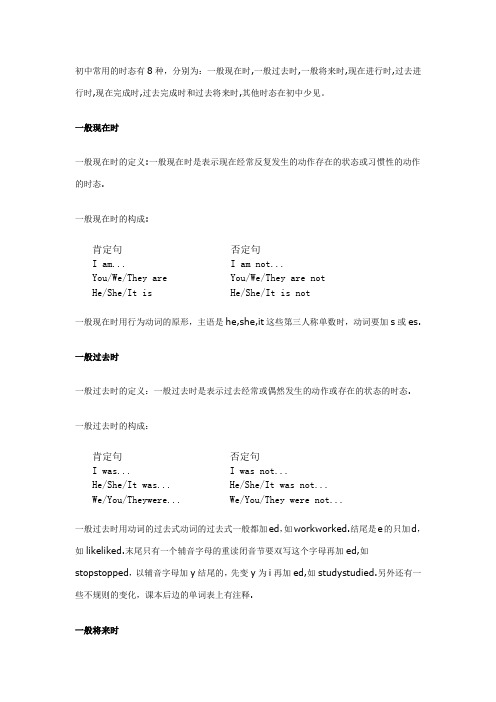
初中常用的时态有8种,分别为:一般现在时,一般过去时,一般将来时,现在进行时,过去进行时,现在完成时,过去完成时和过去将来时,其他时态在初中少见。
一般现在时一般现在时的定义:一般现在时是表示现在经常反复发生的动作存在的状态或习惯性的动作的时态.一般现在时的构成:肯定句否定句I am... I am not...You/We/They are You/We/They are notHe/She/It is He/She/It is not一般现在时用行为动词的原形,主语是he,she,it这些第三人称单数时,动词要加s或es.一般过去时一般过去时的定义:一般过去时是表示过去经常或偶然发生的动作或存在的状态的时态.一般过去时的构成:肯定句否定句I was... I was not...He/She/It was... He/She/It was not...We/You/Theywere... We/You/They were not...一般过去时用动词的过去式动词的过去式一般都加ed,如workworked.结尾是e的只加d,如likeliked.末尾只有一个辅音字母的重读闭音节要双写这个字母再加ed,如stopstopped,以辅音字母加y结尾的,先变y为i再加ed,如studystudied.另外还有一些不规则的变化,课本后边的单词表上有注释.一般将来时一般将来时的定义:一般将来时是表示将来发生的动作或存在的状态的时态.一般将来时的构成:肯定句否定句I/We will go. I/We will not go.You will go. You will not go.He/She/It/They will go. He/She/They will not go.一般将来时由助动词(will,shall)+动词原形构成,shall主要用于以第一人称(I,We)为主语的疑问句中.现在进行时现在进行时的定义:现在进行时是表示在某一时刻或某段时间正在进行的动作的时态.现在进行时的构成:现在进行时由系动词(am,is,are)+现在分词(动词加ing形式)构成.如:肯定句:I am working.疑问句:Am I working?否定句:I am not working.。
初中英语动词八大时态知识点归纳
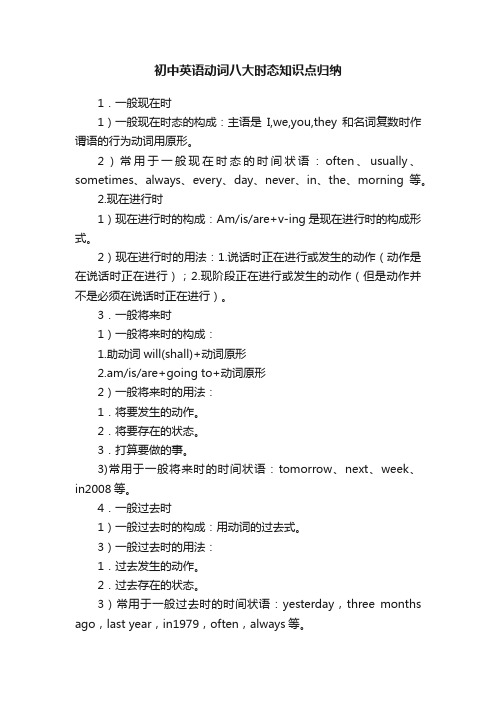
初中英语动词八大时态知识点归纳1.一般现在时1)一般现在时态的构成:主语是I,we,you,they和名词复数时作谓语的行为动词用原形。
2)常用于一般现在时态的时间状语:often、usually、sometimes、always、every、day、never、in、the、morning等。
2.现在进行时1)现在进行时的构成:Am/is/are+v-ing是现在进行时的构成形式。
2)现在进行时的用法:1.说话时正在进行或发生的动作(动作是在说话时正在进行);2.现阶段正在进行或发生的动作(但是动作并不是必须在说话时正在进行)。
3.一般将来时1)一般将来时的构成:1.助动词will(shall)+动词原形2.am/is/are+going to+动词原形2)一般将来时的用法:1.将要发生的动作。
2.将要存在的状态。
3.打算要做的事。
3)常用于一般将来时的时间状语:tomorrow、next、week、in2008等。
4.一般过去时1)一般过去时的构成:用动词的过去式。
3)一般过去时的用法:1.过去发生的动作。
2.过去存在的状态。
3)常用于一般过去时的时间状语:yesterday,three months ago,last year,in1979,often,always等。
5.现在完成时1)现在完成时的构成:have/has+v-ed2)现在完成时的用法:1、表示过去发生的动作对现在造成的影响或结果.常与already,just,ever,never,before等词连用.2、表示“过去的动作”一直延续到现在并有可能继续延续下去.常与for(后跟段时间)或since(后跟点时间)等连用.6、过去进行时1)过去进行时的构成:was/were+v-ing2)过去进行时的用法:过去某一阶段或某一时刻正在进行的动作。
例如:This time last year I was living in Brazil.3)常用于过去进行时的时间状语:at four yesterday afternoon,then,at that time/moment 等。
第1课-初中八大时态
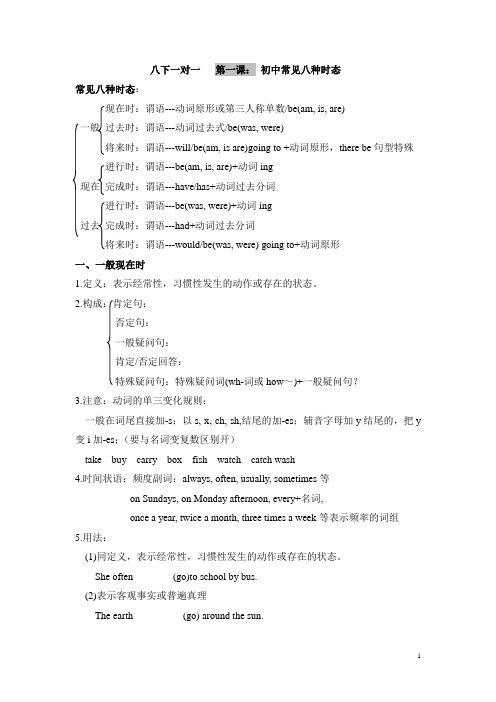
八下一对一第一课:初中常见八种时态常见八种时态:现在时:谓语---动词原形或第三人称单数/be(am, is, are)一般过去时:谓语---动词过去式/be(was, were)将来时:谓语---will/be(am, is are)going to +动词原形,there be句型特殊进行时:谓语---be(am, is, are)+动词ing现在完成时:谓语---have/has+动词过去分词进行时:谓语---be(was, were)+动词ing过去完成时:谓语---had+动词过去分词将来时:谓语---would/be(was, were) going to+动词原形一、一般现在时1.定义:表示经常性,习惯性发生的动作或存在的状态。
2.构成:肯定句:否定句:一般疑问句:肯定/否定回答:特殊疑问句:特殊疑问词(wh-词或how~)+一般疑问句?3.注意:动词的单三变化规则:一般在词尾直接加-s;以s, x, ch, sh,结尾的加-es;辅音字母加y结尾的,把y 变i加-es;(要与名词变复数区别开)take buy carry box fish watch catch wash4.时间状语:频度副词:always, often, usually, sometimes等on Sundays, on Monday afternoon, every+名词,once a year, twice a month, three times a week等表示频率的词组5.用法:(1)同定义,表示经常性,习惯性发生的动作或存在的状态。
She often________(go)to school by bus.(2)表示客观事实或普遍真理The earth__________(go) around the sun.(3)在时间,条件等状语从句中,用现在时表示将来。
(主将从现)If it_________(rain)tomorrow, we won't go to the park.When I grow up, I ____________(go)to America.(4)在某些以here, there开头的句子中用一般现在时表示正在发生的动作。
英语八大时态总结
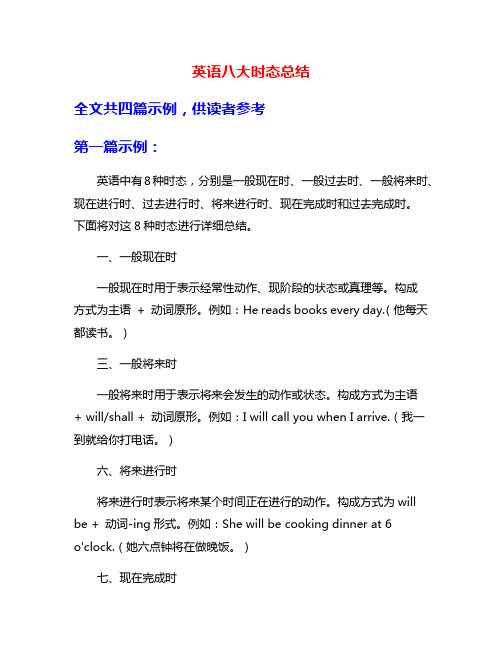
英语八大时态总结全文共四篇示例,供读者参考第一篇示例:英语中有8种时态,分别是一般现在时、一般过去时、一般将来时、现在进行时、过去进行时、将来进行时、现在完成时和过去完成时。
下面将对这8种时态进行详细总结。
一、一般现在时一般现在时用于表示经常性动作、现阶段的状态或真理等。
构成方式为主语+ 动词原形。
例如:He reads books every day.(他每天都读书。
)三、一般将来时一般将来时用于表示将来会发生的动作或状态。
构成方式为主语+ will/shall + 动词原形。
例如:I will call you when I arrive.(我一到就给你打电话。
)六、将来进行时将来进行时表示将来某个时间正在进行的动作。
构成方式为will be + 动词-ing形式。
例如:She will be cooking dinner at 6o'clock.(她六点钟将在做晚饭。
)七、现在完成时现在完成时用于表示过去某个时间开始的动作一直持续到现在,并可能继续发生。
构成方式为主语+ have/has + 过去分词。
例如:He has lived here for 5 years.(他在这里住了5年了。
)总结:1. 一般现在时表示经常性动作、现阶段的状态或真理。
2. 一般过去时表示过去某个时间发生的动作或状态。
3. 一般将来时表示将来会发生的动作或状态。
4. 现在进行时表示现在进行的动作或状态。
5. 过去进行时表示过去某个时间正在进行的动作。
6. 将来进行时表示将来某个时间将会进行的动作。
7. 现在完成时表示过去某个时间开始的动作一直持续到现在。
8. 过去完成时表示过去某个时间之前发生的动作。
掌握这8种时态的用法及构成方式对于学习英语语法和提高英语水平非常重要。
希望以上总结对您有所帮助。
第二篇示例:英语八大时态是学习英语语法非常重要的内容之一,掌握好各种时态的用法可以帮助我们更准确地表达自己的意思。
英语八大时态总结表
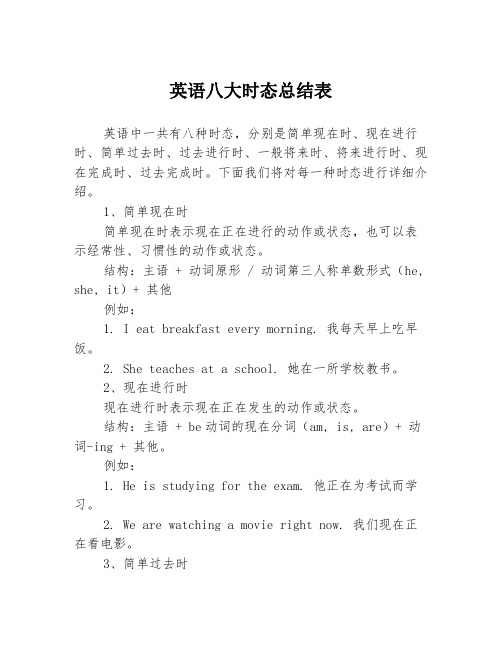
英语八大时态总结表英语中一共有八种时态,分别是简单现在时、现在进行时、简单过去时、过去进行时、一般将来时、将来进行时、现在完成时、过去完成时。
下面我们将对每一种时态进行详细介绍。
1、简单现在时简单现在时表示现在正在进行的动作或状态,也可以表示经常性、习惯性的动作或状态。
结构:主语 + 动词原形 / 动词第三人称单数形式(he, she, it)+ 其他例如:1. I eat breakfast every morning. 我每天早上吃早饭。
2. She teaches at a school. 她在一所学校教书。
2、现在进行时现在进行时表示现在正在发生的动作或状态。
结构:主语 + be动词的现在分词(am, is, are)+ 动词-ing + 其他。
例如:1. He is studying for the exam. 他正在为考试而学习。
2. We are watching a movie right now. 我们现在正在看电影。
3、简单过去时简单过去时表示在过去某个时间发生的动作或状态。
结构:主语 + 动词的过去式 / 动词的第二人称单数形式(you)+ 其他。
例如:1. They went to the beach last summer. 他们去年夏天去了海滩。
2. She talked to her friend on the phone yesterday. 她昨天给她的朋友打电话聊天了。
4、过去进行时过去进行时表示过去某个时间正在进行的动作或状态。
结构:主语 + be动词的过去分词(was, were)+ 动词的现在分词(-ing)+ 其他例如:1. They were playing soccer when it started raining. 下雨的时候他们正在踢足球。
2. She was studying when her phone rang. 她在学习的时候接到了电话。
英语八大时态
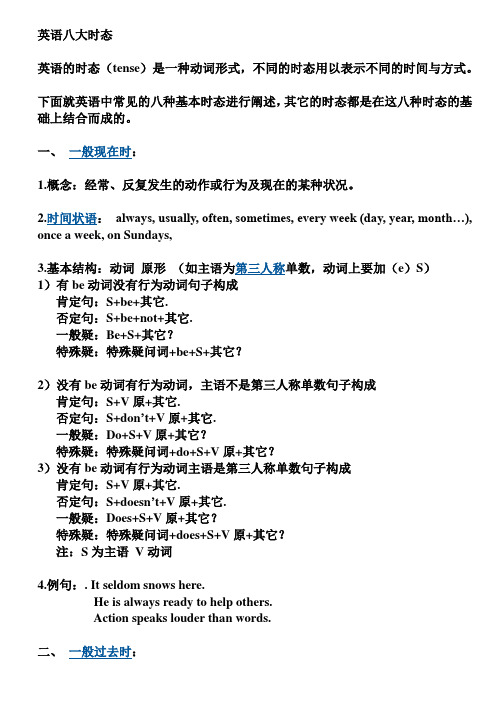
英语八大时态英语的时态(tense)是一种动词形式,不同的时态用以表示不同的时间与方式。
下面就英语中常见的八种基本时态进行阐述,其它的时态都是在这八种时态的基础上结合而成的。
一、一般现在时:1.概念:经常、反复发生的动作或行为及现在的某种状况。
2.时间状语:always, usually, often, sometimes, every week (day, year, month…), once a week, on Sundays,3.基本结构:动词原形(如主语为第三人称单数,动词上要加(e)S)1)有be动词没有行为动词句子构成肯定句:S+be+其它.否定句:S+be+not+其它.一般疑:Be+S+其它?特殊疑:特殊疑问词+be+S+其它?2)没有be动词有行为动词,主语不是第三人称单数句子构成肯定句:S+V原+其它.否定句:S+don’t+V原+其它.一般疑:Do+S+V原+其它?特殊疑:特殊疑问词+do+S+V原+其它?3)没有be动词有行为动词主语是第三人称单数句子构成肯定句:S+V原+其它.否定句:S+doesn’t+V原+其它.一般疑:Does+S+V原+其它?特殊疑:特殊疑问词+does+S+V原+其它?注:S为主语V动词4.例句:. It seldom snows here.He is always ready to help others.Action speaks louder than words.1.概念:过去某个时间里发生的动作或状态;过去习惯性、经常性的动作、行为。
2.时间状语:ago, yesterday, the day before yesterday, last week(year, night, month…), in 1989, just now, at the age of 5, one day, long long ago, once upon a time, etc.3.基本结构:be动词;行为动词1)有be动词没有行为动词句子构成肯定句:S+was/were+其它.否定句:S+was/were+not+其它.一般疑:Was/Were+S+其它?特殊疑:特殊疑问词+ was/were +S+其它?2) 没有be动词有行为动词句子构成肯定句:S+Ved+其它.否定句:S+didn’t+V原+其它.一般疑:Did+S+V原+其它?特殊疑:特殊疑问词+did+S+V原+其它?6.例句:She often came to help us in those days.I didn't know you were so busy.三、现在进行时:1.概念:表示现阶段或说话时正在进行的动作及行为。
英语中八大时态
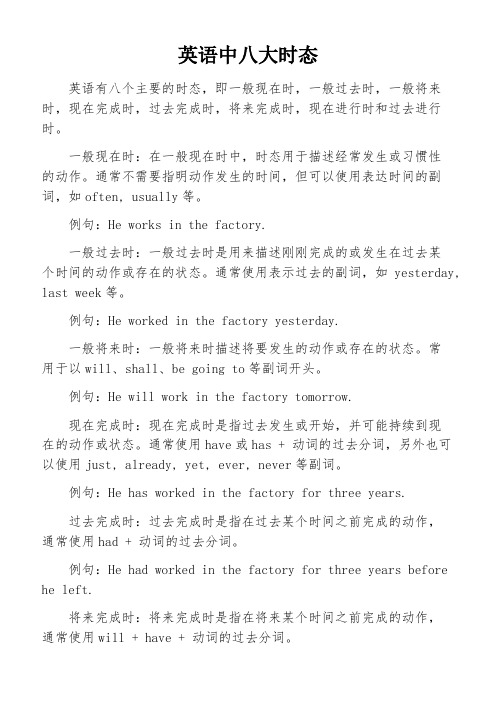
英语中八大时态英语有八个主要的时态,即一般现在时,一般过去时,一般将来时,现在完成时,过去完成时,将来完成时,现在进行时和过去进行时。
一般现在时:在一般现在时中,时态用于描述经常发生或习惯性的动作。
通常不需要指明动作发生的时间,但可以使用表达时间的副词,如often, usually等。
例句:He works in the factory.一般过去时:一般过去时是用来描述刚刚完成的或发生在过去某个时间的动作或存在的状态。
通常使用表示过去的副词,如yesterday, last week等。
例句:He worked in the factory yesterday.一般将来时:一般将来时描述将要发生的动作或存在的状态。
常用于以will、shall、be going to等副词开头。
例句:He will work in the factory tomorrow.现在完成时:现在完成时是指过去发生或开始,并可能持续到现在的动作或状态。
通常使用have或has + 动词的过去分词,另外也可以使用just, already, yet, ever, never等副词。
例句:He has worked in the factory for three years.过去完成时:过去完成时是指在过去某个时间之前完成的动作,通常使用had + 动词的过去分词。
例句:He had worked in the factory for three years before he left.将来完成时:将来完成时是指在将来某个时间之前完成的动作,通常使用will + have + 动词的过去分词。
例句:He will have worked in the factory for three years by the time he leaves.现在进行时:现在进行时是指正在发生的动作或状态,通常使用am/is/are + 动词的现在分词。
初中英语动词八种时态讲解(推荐阅读)
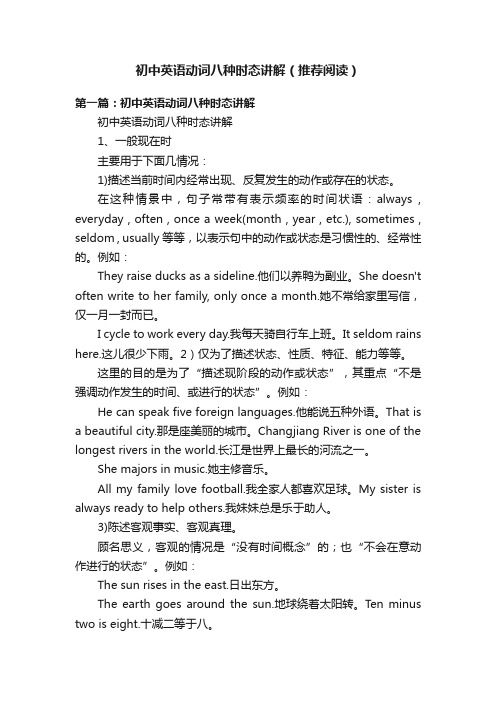
初中英语动词八种时态讲解(推荐阅读)第一篇:初中英语动词八种时态讲解初中英语动词八种时态讲解1、一般现在时主要用于下面几情况:1)描述当前时间内经常出现、反复发生的动作或存在的状态。
在这种情景中,句子常带有表示频率的时间状语:always , everyday , often , once a week(month , year , etc.), sometimes , seldom , usually等等,以表示句中的动作或状态是习惯性的、经常性的。
例如:They raise ducks as a sideline.他们以养鸭为副业。
She doesn't often write to her family, only once a month.她不常给家里写信,仅一月一封而已。
I cycle to work every day.我每天骑自行车上班。
It seldom rains here.这儿很少下雨。
2)仅为了描述状态、性质、特征、能力等等。
这里的目的是为了“描述现阶段的动作或状态”,其重点“不是强调动作发生的时间、或进行的状态”。
例如:He can speak five foreign languages.他能说五种外语。
That is a beautiful city.那是座美丽的城市。
Changjiang River is one of the longest rivers in the world.长江是世界上最长的河流之一。
She majors in music.她主修音乐。
All my family love football.我全家人都喜欢足球。
My sister is always ready to help others.我妹妹总是乐于助人。
3)陈述客观事实、客观真理。
顾名思义,客观的情况是“没有时间概念”的;也“不会在意动作进行的状态”。
例如:The sun rises in the east.日出东方。
英语八大时态归纳总结
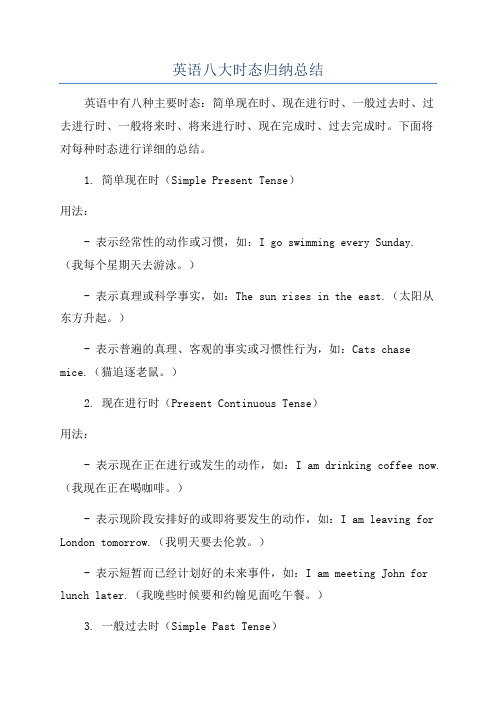
英语八大时态归纳总结英语中有八种主要时态:简单现在时、现在进行时、一般过去时、过去进行时、一般将来时、将来进行时、现在完成时、过去完成时。
下面将对每种时态进行详细的总结。
1. 简单现在时(Simple Present Tense)用法:- 表示经常性的动作或习惯,如:I go swimming every Sunday.(我每个星期天去游泳。
)- 表示真理或科学事实,如:The sun rises in the east.(太阳从东方升起。
)- 表示普遍的真理、客观的事实或习惯性行为,如:Cats chase mice.(猫追逐老鼠。
)2. 现在进行时(Present Continuous Tense)用法:- 表示现在正在进行或发生的动作,如:I am drinking coffee now.(我现在正在喝咖啡。
)- 表示现阶段安排好的或即将要发生的动作,如:I am leaving for London tomorrow.(我明天要去伦敦。
)- 表示短暂而已经计划好的未来事件,如:I am meeting John for lunch later.(我晚些时候要和约翰见面吃午餐。
)3. 一般过去时(Simple Past Tense)用法:- 表示过去发生的一些动作或状态,如:I visited Paris last summer.(我去年夏天去了巴黎。
)- 表示过去的习惯或经常性动作,如:She always ate breakfast before work.(她上班前总是吃早饭。
)- 表示过去一些特定时间的持续状态,如:We lived in that house for 10 years.(我们在那个房子里住了10年。
)4. 过去进行时(Past Continuous Tense)用法:- 表示过去一些时间正在进行或发生的动作,如:They were playing chess when I arrived.(当我到达时,他们正在下棋。
英语八大时态用法详解
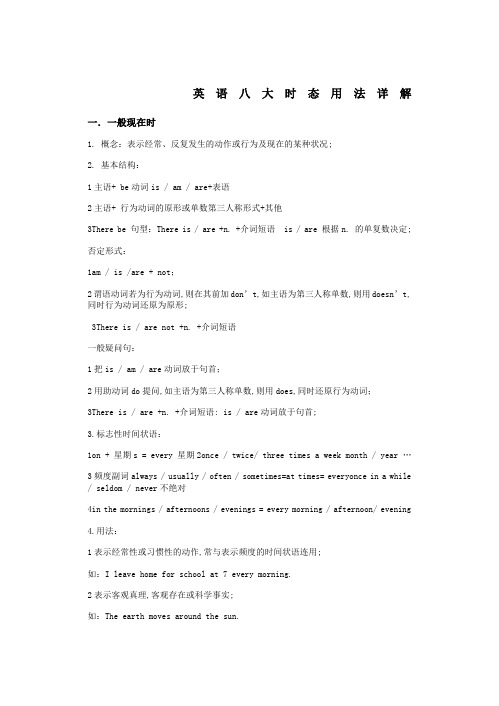
英语八大时态用法详解一.一般现在时1. 概念:表示经常、反复发生的动作或行为及现在的某种状况;2. 基本结构:1主语+ be动词is / am / are+表语2主语+ 行为动词的原形或单数第三人称形式+其他3There be 句型:There is / are +n. +介词短语 is / are 根据n. 的单复数决定;否定形式:1am / is /are + not;2谓语动词若为行为动词,则在其前加don’t,如主语为第三人称单数,则用doesn’t,同时行为动词还原为原形;3There is / are not +n. +介词短语一般疑问句:1把is / am / are动词放于句首;2用助动词do提问,如主语为第三人称单数,则用does,同时还原行为动词;3There is / are +n. +介词短语: is / are动词放于句首;3.标志性时间状语:1on + 星期s = every 星期2once / twice/ three times a week month / year …3频度副词always / usually / often / sometimes=at times= everyonce in a while / seldom / never不绝对4in the mornings / afternoons / evenings = every morning / afternoon/ evening4.用法:1表示经常性或习惯性的动作,常与表示频度的时间状语连用;如:I leave home for school at 7 every morning.2表示客观真理,客观存在或科学事实;如:The earth moves around the sun.3表示格言或警句;如:Pride goes before a fall. 骄者必败;注意:此用法如果出现在宾语从句中,即使主句是过去时,从句谓语也要用一般现在时;如:Columbus proved that the earth is round.4表示现在时刻的状态、能力、性格、个性等;如:I don’t want so much.Ann writes good English but does not speak well.5一般现在时表示将来含义① come, go, arrive, leave, start, begin, return的一般现在时可以表示将来,主要用来表示在时间上已确定或安排好的事情;如:The train leaves at six tomorrow morning.— When does the bus star— It stars in ten minutes.②在时间或条件状语句中;如:When Bill comes 不是will come, ask him to wait for me.I’ll write to you as soon as I arrive there.二.一般过去时1. 概念:表示过去某个时间里发生的动作或状态;过去习惯性、经常性的动作或行为;2. 基本结构:1主语+ was / were +表语2主语+ 行为动词的过去式 +其他3There be 句型:There was / were +n. +介词短语4主语+could+动词原形5主语+used to do sth否定形式:1was / were + not;2在行为动词前加didn’t,同时还原行为动词;3There was / were not +n. +介词短语4主语+could not +动词原形5主语+used not to do sth或主语+didn’t use to do sth一般疑问句:1was或were放于句首;2用助动词do的过去式did 提问,同时还原行为动词;3There was / were +n. +介词短语:was或were放于句首;4could放于句首;5Used主语+ to do sth或Did+主语+use to do sth3.时间状语:1last 短语2时间段+ago 3yesterday及yesterday短语4at the age of = when sb. was+年龄5in one’s teens / twenties6固定短语:just now=a moment ago, one day, from then on, at that time, the day before yesterday, before, long before, in the past , in the / early old days, in the ancient days, in the ancient + 国家,long long ago = once upon a time 故事的开头4. 用法:1在确定的过去时间里所发生的动作或存在的状态;如:Where did you go just now2表示在过去一段时间内,经常性或习惯性的动作;如:When I was a child, I often played football in the street.注意:used to do sth“过去常常做某事”,表示过去习惯性的动作或状态,但如今已不存在;如:Mother used not to be so forgetful. 妈妈过去没这么健忘;3用于时间状语从句a. 由when 引导的时间状语从句,从句用一般过去时态,主句用过去进行时态;如:His mother was cooking when he came back.b. 由since/before 引导的时间状语从句,从句用一般过去时态,主句用现在完成时态;如:I have made many friends since I came to China.It has been/is 15 years since I was a teacher.It has been/is 15 years before he knew it. 不知不觉15 年过去了;c. 由when / by the time/ before引导的时间状语从句,从句用一般过去时态,主句用过去完成时态;如:The plane had taken off when / by the time we arrived at the airport.The Enlish class had begun before I got to school.三.现在进行时1. 概念:表示现阶段或说话时正在进行的动作及行为;2. 基本结构:主语 + am / is /are + doing否定形式:主语 + am / is / are + not + doing一般疑问句:把be动词放于句首;3.时间状语:(1)now 2at this time = at this / the moment 3Look/Look at …4Listen / Listen to …5these days / months / years6It is+ 时间点/日期/星期4. 用法:1表示现在指说话人说话时正在发生的事情;如:We are waiting for you.2表示长期的或重复性的动作,说话时动作未必正在进行;如:Mr Green is writing another novel. 说话时并不一定在写小说3表示动作的渐变,这样的动词有:get, grow, become, turn, run, go, begin等;如:The leaves are turning red.It’s getting warmer and warmer.4与always, constantly, forever 等词连用,表示反复发生的动作或持续存在的状态,往往带有说话人的主观色彩;如:You are always changing your mind. 你老是改变主意;5用现在进行时表示将来下列动词come, go, arrive, leave, start, begin, return等瞬间动词的现在进行时可以表示将来;如:I’m leaving tomorrow.四.过去进行时1. 概念:表示过去某段时间或某一时刻正在发生或进行的行为或动作;如:My brother fell while he was riding his bicycle and hurt himself.2. 基本结构:主语 + was / were + doing否定形式:主语 + was / were + not + doing一般疑问句:把was或were放于句首;3. 时间状语:1at that time2at this time+过去的时间3It was+ 时间点/ 日期/ 星期过去4from A时间 to B时间+过去的时间4. 用法:1过去进行时表示过去某段时间内持续进行的动作或者事情;如:We were watching TV from seven to nine last night.2过去进行时可以表示在过去某个时间点发生的事情;时间点可以用介词短语、副词或从句来表示;如:What was she doing at nine o’clock yesterday 介词短语表示时间点She was doing her homework then. 副词表示时间点When I saw him he was decorating his room. when从句表示时间点3在复合句中,如果主要动作和背景动作都是延续的或同时发生的,那么主从句的动词都可用过去进行时;如:When he was waiting for the bus, he was reading a newspaper. 两个动作都是延续的He was cleaning his car while I was cooking. 两个动作同时进行或主句的动作发生在从句的动作过程中五.一般将来时1. 概念:表示将要发生的动作或存在的状态及打算、计划或准备做某事;2. 基本结构:1主语 + am / is / are / going to do sth2主语 + will do sth3主语 + am / is /are t to do sth 4主语 + am / is /are about to do sth否定形式:1主语 + am / is /are + not + going to do sth2主语 + will notwon’t do sth3主语 + am / is /are not t to do sth 4主语 + am / is /are not about to do sth一般疑问句:1am / is / are放于句首;2will置于句首;3am / is / are放于句首;4am / is / are放于句首;2. 时间状语:1tomorrow及其短语、 the day after tomorrow2next短语3固定短语:one day, someday = some day, in the future, from now / today on, before long, sometime, in +时间段多长时间之后, in following+ 时间段4. will主要用于以下三个方面:1表示主观意愿的将来;如:They will go to visit the factory tomorrow.2表示不以人的意志为转移的客观的将来;如:Today is Saturday. Tomorrow will be Sunday.He will be thirty years old this time next year.3表示临时决定,通常用于对话中;— Mary has been ill for a week.— Oh, I didn’t know. I will go and see her.5. be going to主要用于以下两个方面:1表示事先经过考虑、打算、计划要做某事;如:Dad and I are going to watch an opera this afternoon.今天下午我和爸爸打算去看歌剧;2表示根据目前某种迹象判断,某事非常有可能发生,表示推测;如:Look There come the dark clouds. It is going to rain.6. 用于状语从句由when /as soon as / begore / after 等引导的时间状语从句或者if, unless, as/ so long as 引导的条件状语从句,从句用一般现在时态或从句为祈使句,再或者从句中含有情态动词,主句用一般将来时态;可理解为主将从现、主祈从现、主情从现如:Don’t trouble troubles until trouble troubles you.He will help you out whenever you have problems.I won't go to the partyunlessI'm invited.六.过去将来时1. 概念:立足于过去某一时刻,从过去看将来,常用于宾语从句中;2. 基本结构:1主语 + was / were / going to do sth2主语 + would do sth否定形式:1主语 + was / were / not + going to do sth2主语 + would + not + do sth一般疑问句:1was或were放于句首;2would 提到句首;3. 时间状语:the next day morning, year, the following month week等;4. 用法:1“would + 动词原形”常表示主观意愿的将来;如:He said he would come to see me. 他说他要来看我;2“was / were + going to + 动词原形”常表示按计划或安排即将发生的事;如:She said she was going to start off at once.I was told that he was going to return home.此结构还可表示根据某种迹象来看,很可能或即将发生的事情;如:It seemed as if it was going to rain. 看来好像要下雨;3come,go,leave,arrive,start等瞬时动词可用过去进行时表示过去将来的含义;如:He said the train was leaving at six the next morning.She told me she was coming to see me.七.现在完成时1. 概念:过去发生或已经完成的动作对现在造成的影响或结果,或从过去已经开始持续到现在并且有可能继续下去的动作或状态;3. 基本结构:主语 + have / has + done +其他否定形式:主语 + have / has + not +done +其他一般疑问句:Have / Has +主语 + done +其他4. 时间状语:1already 用于肯定句yet否定句和一般疑问句2just, ever, before, never3so far=up to now = until / till now = by now4over/ in the past /last +时间段5by + 时间6by the end of +现在的时间7since +过去时间如具体的年、月、日、钟点等,如:1980, last month, half past six8 since +一段时间+ ago 9recently = lately10in recent +时间段5. 特殊用法:1由since/before 引导的时间状语从句,从句用一般过去时态,主句用现在完成时态;如:I have made many friends since I came to China.It has been/is 15 years since I was a teacher.It has been/is 15 years before he knew it. 不知不觉15 年过去了;(2)用于由that引导的定语从句中,先行词前有形容词的最高级修饰;如:You’re the best teacher that has ever taught me.6. 比较since和forsince 用来说明动作起始时间,for用来说明动作延续时间的长度;如:We haven’t had any guests since we moved in here.I have lived here for more than twenty years.注意:并非有for 作为时间状语的句子都用现在完成时;I worked here for more than twenty years. 我现在已不在这里工作;7. 延续性动词与非延续性动词之间的转换:leave --- be away from borrow --- keep buy --- have begin/start --- be ondie --- be dead finish --- be over open sth --- keep sth openjoin --- be in+组织机构或be a member of+组织机构fall ill / asleep --- be ill / asleep get up---be upcatch / get a cold --- have a cold come here --- be here go there --- be therebecome / get +adj.--- be+adj come back --- be back get to/ arrive/reach --- be inget to know --- know go get out ---be out put on--- wear/ be in /be dressed in八.过去完成时1. 概念:以过去某个时间为参照,在此以前发生的动作或行为,或在过去某动作之前已完成的动作,即“过去的过去”;2. 基本结构:主语 + had done +其他否定形式:主语 + hadn’t done +其他一般疑问句:had置于句首;3. 时间状语:before, by the end of last yearterm, month等;4. 用法:1用于told, said, knew, heard, thought等动词后的宾语从句中;如:She said that she had never been to Paris.2由when / by the time/ before引导的时间状语从句,从句用一般过去时态,主句用过去完成时态;如:The plane had taken off when / by the time we arrived at the airport.The Enlish class had begun before I got to school.When the police arrived, the thieves had run away.3表示意向的动词,如hope, wish, expect, think, intend, mean, suppose等用过去完成时表示“原本······,未能······”;如:We had hoped that you would come, but you didn’t.注意: had hardly… when ... 刚······就······;如:I had hardly opened the door when he hit me. 我刚打开门,他就打了我; had no sooner…than 刚······就······;如:He had no sooner bought the car than he sold it. 他刚买了这辆车,转眼又卖了;。
英语八大时态概念
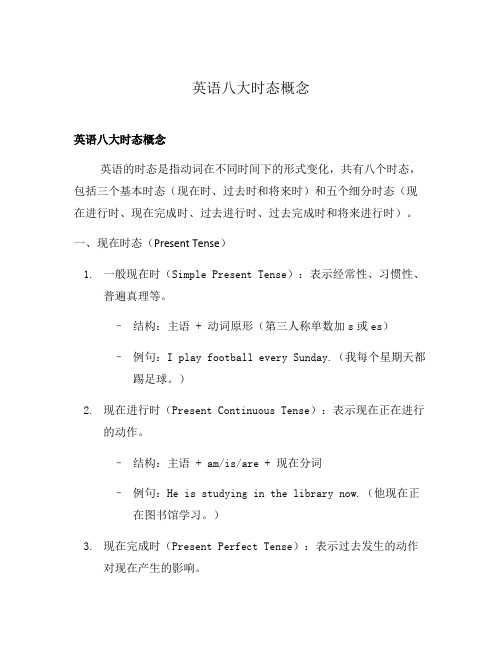
英语八大时态概念英语八大时态概念英语的时态是指动词在不同时间下的形式变化,共有八个时态,包括三个基本时态(现在时、过去时和将来时)和五个细分时态(现在进行时、现在完成时、过去进行时、过去完成时和将来进行时)。
一、现在时态(Present Tense)1.一般现在时(Simple Present Tense):表示经常性、习惯性、普遍真理等。
–结构:主语 + 动词原形(第三人称单数加s或es)–例句:I play football every Sunday.(我每个星期天都踢足球。
)2.现在进行时(Present Continuous Tense):表示现在正在进行的动作。
–结构:主语 + am/is/are + 现在分词–例句:He is studying in the library now.(他现在正在图书馆学习。
)3.现在完成时(Present Perfect Tense):表示过去发生的动作对现在产生的影响。
–结构:主语 + have/has + 过去分词–例句:I have visited Beijing many times.(我去过北京很多次。
)二、过去时态(Past Tense)1.一般过去时(Simple Past Tense):表示过去某个时间发生的动作或存在的状态。
–结构:主语 + 动词过去式–例句:She watched a movie last night.(她昨晚看了一部电影。
)2.过去进行时(Past Continuous Tense):表示过去某个时间正在进行的动作。
–结构:主语 + was/were + 现在分词–例句:They were playing basketball at 8 o’clock yesterday evening.(昨晚8点他们正在打篮球。
)3.过去完成时(Past Perfect Tense):表示过去某一时间或动作发生在另一过去时间之前。
英语八大时态归纳总结

1、一般现在时概念:经常、反复发生的动作或行为及现在的某种状况..时间状语:always; usually; often; sometimes; every week day; year; month…; once a week; on Sundays; etc.基本结构:①be动词;②行为动词否定形式:①am/is/are+not; ②此时态的谓语动词若为行为动词;则在其前加don't;如主语为第三人称单数;则用doesn't;同时还原行为动词..一般疑问句:①把be动词放于句首;②用助动词do提问;如主语为第三人称单数;则用does;同时;还原行为动词..2、一般过去时概念:过去某个时间里发生的动作或状态;过去习惯性、经常性的动作、行为..时间状语:ago; yesterday; the day before yesterday; last weekyear; night; month…; in 1989; just now; at the age of 5; one day; long long ago; once upon a time; etc.基本结构:①be动词;②行为动词否定形式:①was/were+not;②在行为动词前加didn't;同时还原行为动词..一般疑问句:①was或were放于句首;②用助动词do的过去式did 提问;同时还原行为动词..3、现在进行时概念:表示现阶段或说话时正在进行的动作及行为..时间状语:now; at this time; these days; etc.基本结构:am/is/are+doing否定形式:am/is/are+not+doing.一般疑问句:把be动词放于句首..4、过去进行时概念:表示过去某段时间或某一时刻正在发生或进行的行为或动作..时间状语:at this time yesterday; at that time或以when引导的谓语动词是一般过去时的时间状语等..基本结构:was/were+doing否定形式:was/were + not + doing.一般疑问句:把was或were放于句首..5、现在完成时概念:过去发生或已经完成的动作对现在造成的影响或结果;或从过去已经开始;持续到现在的动作或状态..时间状语:recently; lately; since…for…;in the past few years; etc.基本结构:have/has + done否定形式:have/has + not +d one.一般疑问句:have或has..6、过去完成时概念:以过去某个时间为标准;在此以前发生的动作或行为;或在过去某动作之前完成的行为;即“过去的过去”..时间状语:before; by the end of last yearterm; month…;etc.基本结构:had + done.否定形式:had + not + done.一般疑问句:had放于句首..7、一般将来时概念:表示将要发生的动作或存在的状态及打算、计划或准备做某事..时间状语:tomorrow; next dayweek; month; year…;soon; in a few minutes; by…;the day after tomorrow; etc.基本结构:①am/is/are/going to + do;②will/shall + do.否定形式:①was/were + not; ②在行为动词前加didn't;同时还原行为动词..一般疑问句:①be放于句首;②will/shall提到句首..8、过去将来时概念:立足于过去某一时刻;从过去看将来;常用于宾语从句中..时间状语:the next daymorning; year…;the following monthweek…;etc.基本结构:①was/were/going to + do;②would/should + do.否定形式:①was/were/not + going to + do;②would/should + not + do.一般疑问句:①was或were放于句首;②would/should 提到句首..几种常见时态的相互转换英语中的几种时态在一定情况下可以互相转换;以下是几种常见的转换形式:1、一般过去时与现在完成时的转换在现在完成时中;延续性动词能与表示一段时间的状语连用;瞬间动词却不能..但是;可用别的表达方式:①瞬间动词用于“一段时间 + ago”的一般过去时的句型中;②瞬间动词可改成与之相对应的延续性动词及短语;与一段时间连用;③瞬间动词用于“It is + 一段时间 + since + 一般过去时”的句型中;表示“自从……以来有……时间”的意思;主句一般用it is来代替It has been;④瞬间动词用于“Some time has passed since + 一般过去时”的句型中..请看:A. He joined the League two years ago.B. He has been in the League for two years.C. It is two years since he joined the League.D. Two years has passed since he joined the League.2、一般现在时与现在进行时的转换在一般现在时中;at加上名词表示“处于某种状态”;如at work在工作; at school上学、上课等..此短语可与进行时态转换..请看:Peter is at work; but Mike is at play.Peter is working; but Mike is playing.3、现在进行时与一般将来时的转化换在现在进行时态中go; come; leave; start; arrive等动词常与表示将来的时间状语连用表示将要发生的动作..如:I am coming; Mum 意为“我就来;妈妈”请看:The train is leaving soon.The train will leave soon.4、“be going to+动词原形”与“willshall+动词原形”结构的转换“be going to+动词原形”、表示打算、计划要做的事;将来时“willshall+动词原形”结构在书面语中;当主语为第一人称时;常用助动词shall..在口语中;所有人称都可以用will..请看:We are going to visit the Great Wall next Sunday.We shall visit the Great Wall next Sunday.。
初中英语必考八大时态结构及用法详解
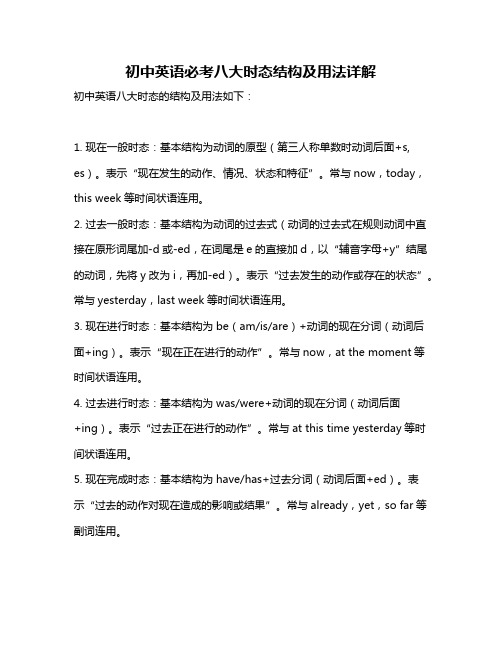
初中英语必考八大时态结构及用法详解初中英语八大时态的结构及用法如下:1. 现在一般时态:基本结构为动词的原型(第三人称单数时动词后面+s, es)。
表示“现在发生的动作、情况、状态和特征”。
常与now,today,this week等时间状语连用。
2. 过去一般时态:基本结构为动词的过去式(动词的过去式在规则动词中直接在原形词尾加-d或-ed,在词尾是e的直接加d,以“辅音字母+y”结尾的动词,先将y改为i,再加-ed)。
表示“过去发生的动作或存在的状态”。
常与yesterday,last week等时间状语连用。
3. 现在进行时态:基本结构为be(am/is/are)+动词的现在分词(动词后面+ing)。
表示“现在正在进行的动作”。
常与now,at the moment等时间状语连用。
4. 过去进行时态:基本结构为was/were+动词的现在分词(动词后面+ing)。
表示“过去正在进行的动作”。
常与at this time yesterday等时间状语连用。
5. 现在完成时态:基本结构为have/has+过去分词(动词后面+ed)。
表示“过去的动作对现在造成的影响或结果”。
常与already,yet,so far等副词连用。
6. 过去完成时态:基本结构为had+过去分词(动词后面+ed)。
表示“过去的动作在过去的某个时间之前已经完成或发生的动作或存在的状态”。
常与by the end of last year,by the time of等时间状语连用。
7. 现在完成进行时态:基本结构为have/has been+动词的现在分词(动词后面+ing)。
表示“动作从过去某时开始,一直延续到现在,或者刚刚完成”。
常与for several days,since等时间状语连用。
8. 过去完成进行时态:基本结构为had been+动词的现在分词(动词后面+ing)。
表示“过去的某个动作从过去某时开始,一直延续到过去的某个时间,或者刚刚完成”。
初中英语八大时态笔记
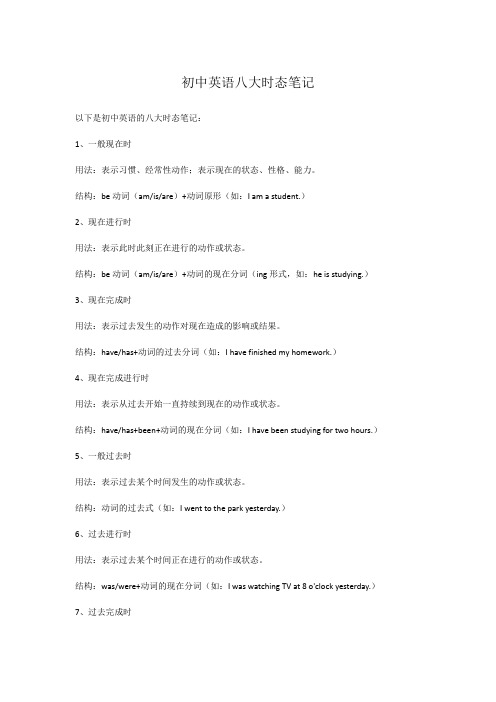
初中英语八大时态笔记以下是初中英语的八大时态笔记:1、一般现在时用法:表示习惯、经常性动作;表示现在的状态、性格、能力。
结构:be动词(am/is/are)+动词原形(如:I am a student.)2、现在进行时用法:表示此时此刻正在进行的动作或状态。
结构:be动词(am/is/are)+动词的现在分词(ing形式,如:he is studying.)3、现在完成时用法:表示过去发生的动作对现在造成的影响或结果。
结构:have/has+动词的过去分词(如:I have finished my homework.)4、现在完成进行时用法:表示从过去开始一直持续到现在的动作或状态。
结构:have/has+been+动词的现在分词(如:I have been studying for two hours.)5、一般过去时用法:表示过去某个时间发生的动作或状态。
结构:动词的过去式(如:I went to the park yesterday.)6、过去进行时用法:表示过去某个时间正在进行的动作或状态。
结构:was/were+动词的现在分词(如:I was watching TV at 8 o'clock yesterday.)7、过去完成时用法:表示在过去某个时间之前已经完成的动作或状态。
结构:had+动词的过去分词(如:I had finished my homework before dinner.)8、过去完成进行时用法:表示在过去某个时间之前一直持续到那个时间的动作或状态。
结构:had been+动词的现在分词(如:I had been studying for two hours before dinner.)。
英语八大时态
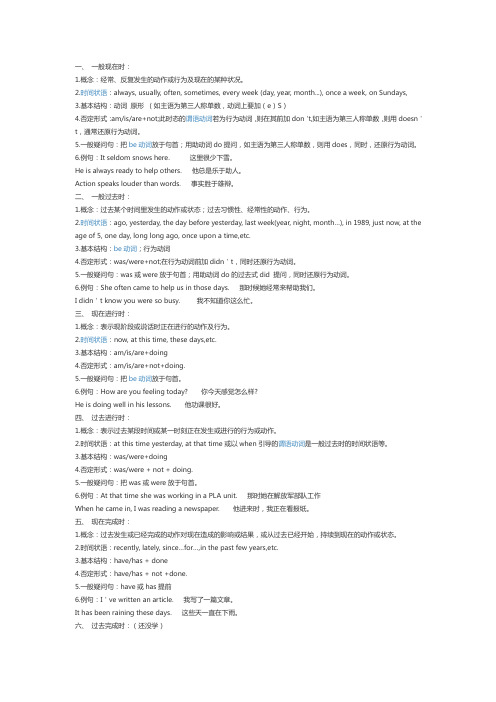
一、一般现在时:1.概念:经常、反复发生的动作或行为及现在的某种状况。
2.时间状语:always, usually, often, sometimes, every week (day, year, month...), once a week, on Sundays,3.基本结构:动词原形(如主语为第三人称单数,动词上要加(e)S)4.否定形式:am/is/are+not;此时态的谓语动词若为行为动词,则在其前加don't,如主语为第三人称单数,则用doesn't,通常还原行为动词。
5.一般疑问句:把be动词放于句首;用助动词do提问,如主语为第三人称单数,则用does,同时,还原行为动词。
6.例句:It seldom snows here. 这里很少下雪。
He is always ready to help others. 他总是乐于助人。
Action speaks louder than words. 事实胜于雄辩。
二、一般过去时:1.概念:过去某个时间里发生的动作或状态;过去习惯性、经常性的动作、行为。
2.时间状语:ago, yesterday, the day before yesterday, last week(year, night, month…), in 1989, just now, at the age of 5, one day, long long ago, once upon a time,etc.3.基本结构:be动词;行为动词4.否定形式:was/were+not;在行为动词前加didn't,同时还原行为动词。
5.一般疑问句:was或were放于句首;用助动词do的过去式did 提问,同时还原行为动词。
6.例句:She often came to help us in those days. 那时候她经常来帮助我们。
I didn't know you were so busy. 我不知道你这么忙。
初中英语动词八大时态详解
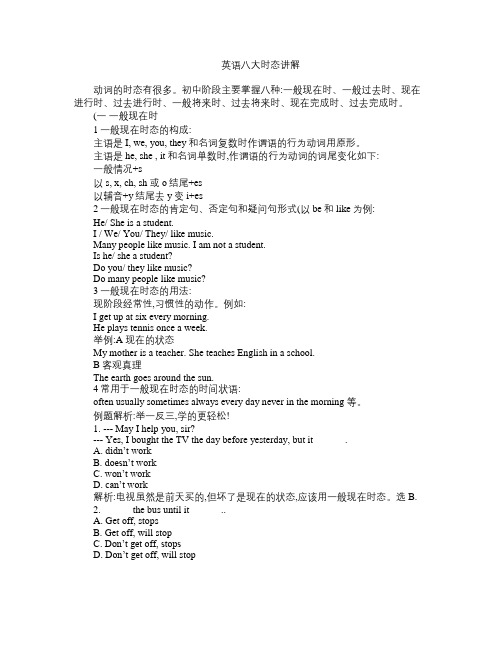
英语八大时态讲解动词的时态有很多。
初中阶段主要掌握八种:一般现在时、一般过去时、现在进行时、过去进行时、一般将来时、过去将来时、现在完成时、过去完成时。
(一一般现在时1一般现在时态的构成:主语是I, we, you, they和名词复数时作谓语的行为动词用原形。
主语是he, she , it和名词单数时,作谓语的行为动词的词尾变化如下:一般情况+s以s, x, ch, sh 或o结尾+es以辅音+y结尾去y变i+es2一般现在时态的肯定句、否定句和疑问句形式(以be和like为例:He/ She is a student.I / We/ You/ They/ like music.Many people like music. I am not a student.Is he/ she a student?Do you/ they like music?Do many people like music?3一般现在时态的用法:现阶段经常性,习惯性的动作。
例如:I get up at six every morning.He plays tennis once a week.举例:A 现在的状态My mother is a teacher. She teaches English in a school.B 客观真理The earth goes around the sun.4常用于一般现在时态的时间状语:often usually sometimes always every day never in the morning 等。
例题解析:举一反三,学的更轻松!1. --- May I help you, sir?--- Yes, I bought the TV the day before yesterday, but it ______.A. didn’t workB. doesn’t workC. won’t workD. can’t work解析:电视虽然是前天买的,但坏了是现在的状态,应该用一般现在时态。
英语动词时态表
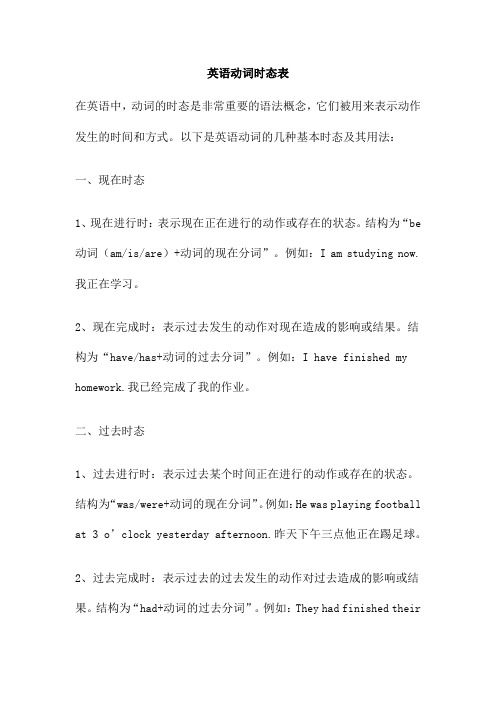
英语动词时态表在英语中,动词的时态是非常重要的语法概念,它们被用来表示动作发生的时间和方式。
以下是英语动词的几种基本时态及其用法:一、现在时态1、现在进行时:表示现在正在进行的动作或存在的状态。
结构为“be 动词(am/is/are)+动词的现在分词”。
例如:I am studying now.我正在学习。
2、现在完成时:表示过去发生的动作对现在造成的影响或结果。
结构为“have/has+动词的过去分词”。
例如:I have finished my homework.我已经完成了我的作业。
二、过去时态1、过去进行时:表示过去某个时间正在进行的动作或存在的状态。
结构为“was/were+动词的现在分词”。
例如:He was playing football at 3 o’clock yesterday afternoon.昨天下午三点他正在踢足球。
2、过去完成时:表示过去的过去发生的动作对过去造成的影响或结果。
结构为“had+动词的过去分词”。
例如:They had finished theirwork before we came.在我们来到之前,他们已经完成了他们的工作。
三、将来时态1、将来进行时:表示将来某个时间正在进行的动作或存在的状态。
结构为“will be+动词的现在分词”。
例如:I will be studying at 8 o’clock tomorrow morning.我将在明天早上八点学习。
2、将来完成时:表示将来某个时间已经完成的动作或存在的状态。
结构为“will have+动词的过去分词”。
例如:I will have finished my homework by 10 o’clock tomorrow night.我将在明天晚上十点之前完成我的作业。
以上是英语动词的几种基本时态及其用法,理解和掌握这些时态对于正确使用英语有着重要的意义。
在英语中,动词的时态是非常重要的语法概念,因为它表达了动作发生的时间和状态。
- 1、下载文档前请自行甄别文档内容的完整性,平台不提供额外的编辑、内容补充、找答案等附加服务。
- 2、"仅部分预览"的文档,不可在线预览部分如存在完整性等问题,可反馈申请退款(可完整预览的文档不适用该条件!)。
- 3、如文档侵犯您的权益,请联系客服反馈,我们会尽快为您处理(人工客服工作时间:9:00-18:30)。
一、动词的形式与 动词的时态有什么关系? 二、学英语,特别是英语 写作练习时,你有意识地 注意到动词的时态吗?
1、be式动词: 一般现在时 is am are 2、实义动词: 难点:当主语为第三人称单数 时,V+ S(注意动词+s的方法) 疑问找助动词:do, does 否定找助动词:don’t ,doesn’t
would do would be would doing
have done been doing
描述在过去的时间里所发生的事情, 与现在无关,只能与表示过去的时间 状语连用。如: •I wrote an English letter last night. •I have written an English .
•We learnt 300 English words last term.
•We have learnt 400 English words since last term. • Great changes have taken place in ou hometown during the last 10 years.
5、一般将来时: 写一个句 请问“你把教室的门口关上了么” 子,好吗 ? 怎么翻译 6、含有情态动词的被动语态 情态动词 + be + done 情态动词: can, could ,may,might, shall,should must,(had to)
说出下列句子中动词的形式
1. He spends 20 minutes in English every day. 2. Our English teacher went to the Great Wall last month. 3. Look! They are playing basketball over there. 4. What were you doing last night? I was doing my lessons. 5. What have you done with the meat? I have just eaten it. 6. He had learnt some English before he went to our school.
时态专项
以动词write 为例写出下列句子
1. 2. 3. 4. 5. 6. 7. 她每周写一封英文信。 她上星期写了一封英文信。 看!她在那边写一封英文信。 下星期天她要写一封英文信。 昨天下午她在写一封英文信。 她说她要写一封英文信给妮卡。 她已经给妮卡写了一封英文信。 她已经给妮卡写英文信了吗? 8. 到上学期末她已写了10封英文信。
说出下列句子中动词的形式
7. We will go to have a picnic if it does not rain next Sunday. 8. I really didn’t know what I would do next. 9. To help people is helping people. 10. Getting up early is good for your health. 11. I often hear her sing the song, 12. We watched them playing football yesterday 13. Did the little bird made of wood sing every full hour? 14. The students went out of the classroom, talking and smiling.
时
式
一般
进行
完成
完成进行
现在
一般现在 现在进行 现在完成 现 在 完 成 进 时 时 时 行时
过去
一般过去 过去进行 过去完成 过去完成进 时 时 时 行时
将来
一般将来 将来进行 将来完成 将来完成进 时 时 时 行时
过去将 过去将来 过去将来 过去将来 过去将来完 来 时 进行时 完成时 成进行时
六、过去完成时:过去的过去 在过去某时间(或动作)看来已经 完成了的动作 :had + done 常见的句型: ①过去完成时 + by the time …
②过去完成时 + by the end of+ 过去的时间 ③过去完成时+ when + 一般过去时的句子 ④过去完成时+ before + 一般过去时的句子 ⑤After + 过去完成时 ,+ 一般过去时的句子
3、难点: ①现在完成时中,终止(一次)性 动作的动词不用于For + 多长时间 (或how long )的句型中。如:go,come, begin,start,leave,open,close,sell,buy,take, bring,die等。 ②have /has + gone to 与have / has been to ③现在完成时与一般过去时的区别: 现在完成时指动作发生在过去对现在造成 的结果或影响,与现在有关,不与表示 过去的时间状语连用;而一般过去时纯粹
现 1、have/ has + done 在 (动作发生在过去对现在造成的 完 结果或影响) 成 2、常见的时间状语或句型 时 ①already,just,ever,never,yet
②现在完成时 +since + 过去的时间 ③现在完成时+since+ 一般过去时句子 ④现在完成时+ during(in)+the last… ⑤现在完成时 + for + 多长时间
请写出下列时态的被动语态 1、一般现在时: is / am / are + done 2、一般过去时: was / were + done 3、现在进行时: is / am / are + being done 4、现在完成时: have / has + been done
5、一般将来时的被动语态 will + be done is / are going to be done 6、含有情态动词的被动语态 can / could , may / might shall / should , must / had to + be done
八、过去将来时:在过去某时间 (或某动作)看来将要发生的动作。 1、would + do 2、was / were + going to do 过去将来时常用于宾语从句中 • I heart that they would help us .
• He said that he was going to play footbal • I didn’t know if they would come. • We didn’t know what they were going to do next Sunday.
⑥ 一般过去时(主句)+ 过去完成时(宾语从句)
七、一般将来时:在现在看来将要 发生的动作。 1、will + do 2、be + going to do 常用的时间状语: tomorrow, next …, in (以后多长时间) 3、go,come,leave ,have的进行时态可以 表示一个将来的动作 考点:主句为一般将来时,从句(条件) 用一般现在时。 •We will not go out if it snows tomorrow. •I will give the letter to her as soon as she comes back tomorrow.
1、be 式动词: was were 一般过去时 2、实义动词: 使用动词的过去式 (分为规则与不规则) 疑问否定:did, did’t
is / am /are + doing (注意现在分词的构成) 1、直接+ing 2、去掉e,+ ing 现在进行时 3、双写+ing
过去进行时
was / were + doing 注意过去进行时与一般过去时的 区别: 1、意义上:过去进行时指过去某 点或某段时间正在进行的动作;而 一般过去时指在过去的时间里所 发生事实。 2、动词使用的形式不同
时
式
一般
进行
完成
完成进行
现在
do / does am / is /
have / has have / has been doing had been doing will have done will have been doing would have
are doing done 过去 did were / was had done doing 将来 will / shall will be do 过去将 来 doing
